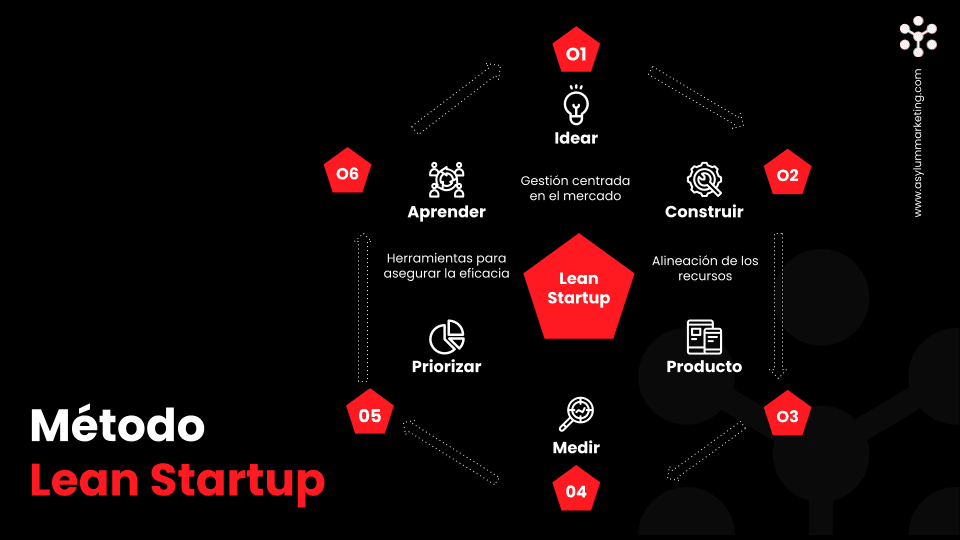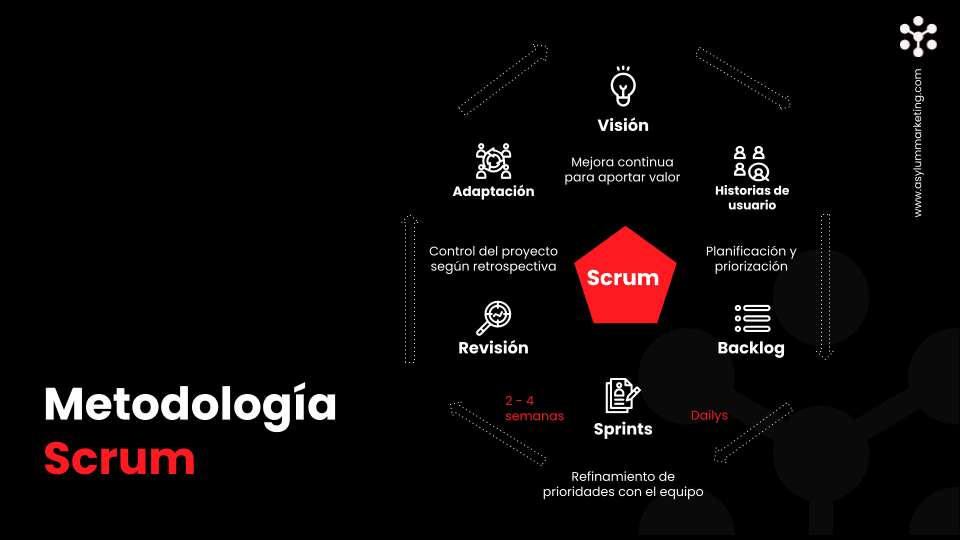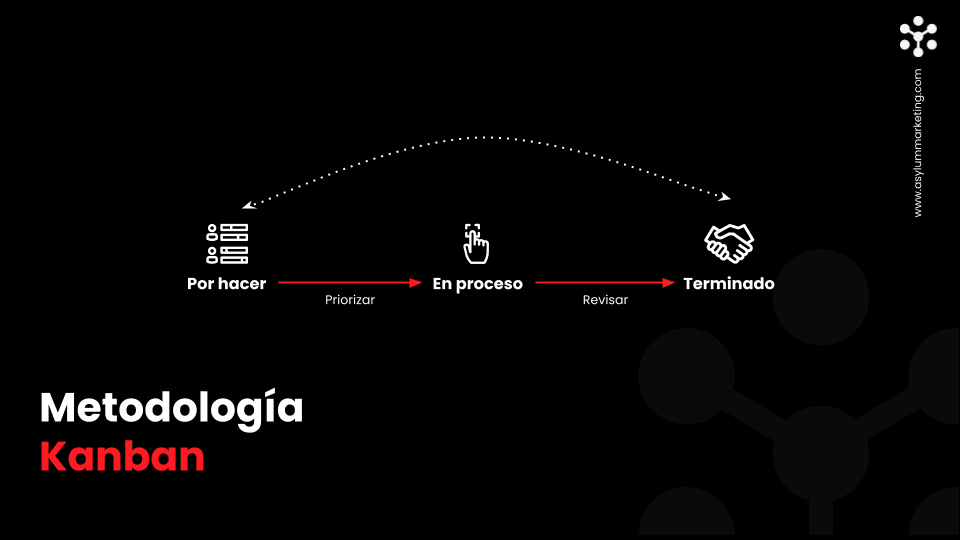Agile methodologies in Growth Marketing

ASTRID CAMARGO
Growth Manager
Project management with agile methodologies in Growth Marketing are the pillar of the scientific method to generate value for our end customer.
New technologies for the diagnosis and measurement of data have allowed the development of digital products and software, based on these clear and defined objectives from market research.
The purpose of implementing an agile methodology and processes within an area of marketing knowledge is directly related to the change of mentality of people and the effectiveness of teamwork.
Agile methodologies and productive processes in Growth are part of the digital strategy and answer the questions: What will we do? How will we do it? Why will we do it? And why will we do it?
At Asylum we offer solutions for the accelerated growth of brands thanks to business intelligence obtained by data, to facilitate the work of marketing specialists and experimentation in Growth Hacking.
Find out how we can advise you to create a customer-centric digital strategy using data and technologies, contact Asylum Marketing here.
What are agile methodologies?
Agile methodologies are those processes that allow adapting the way teams work according to the needs of the project.
What are agile methodologies for?
They allow the generation of autonomous, flexible, productive and efficient work environments to deliver products and/or services with greater value, at lower costs and in shorter times.

Growth Marketing process in Asylum applied to leading brands in the world.
For Asylum, applying the Lean philosophy is the driving force behind our purposeful thinking model. It allows us to create an innovative approach to developing new digital products and services.
The idea is to experiment and learn quickly and continuously through hypothesizing and measuring KPIs and OKRs defined in the digital strategy.
Here is a list of agile methodologies popular not only in the development sector but also in marketing and advertising that can be useful for your teams and how it has worked for us at Asylum for the sustainable growth of our partner brands.
Agile marketing is the most efficient way to work, and it is a must for our days along with the evolution of artificial intelligence in the advertising field.
Most used agile methodologies
Lean Startup:
It is an effective method for experimentation and constant learning in order to build products and generate value to the end customer. It is the most popular methodology in the field of Growth.

Lean Startup Method: it is a continuous cycle of learning and improvement. Validating hypotheses and applying them to your product or service is key to be more attractive to your end customers.
How to apply the Lean Startup method to my project?
- Define the main and secondary objectives: After the consolidated brief with the client (company) it is important to highlight the why and wherefore of the project.
- Identify the hypotheses to validate: Recognize a problem or need to solve and how you can solve them. To do a validation with real users, you can do it through surveys and testing prototypes in order to test if the proposed solution is ideal for your end customers.
- Create an MVP: A minimum viable product allows you to test a hypothesis in an agile way and then go into iterations and improvements.
The hierarchy of needs by behavior and motivation can be defined by Maslow’s pyramid where the first thing a digital product has to do is to be functional, in this Maslow and Walter agree. - Measuring metrics: It is important to define from the main and secondary objectives which are the metrics you want to reach to scale the solutions to customers.
- Constant iteration: Learning and improving from the validation of hypotheses is part of the Lean Startup philosophy process. It is relevant to have real customer feedback to collect data that can be useful for product and service improvements.
KPIs or metrics to validate hypotheses
- Target success rate: Equivalent to the proportion of users who complete the task successfully. Expected to influence 1.5% of the total number of users.
- Dwell time: If the average of users is higher than 1 minute, we can take the behavior of users in the MVP and make improvements based on that data, if it is lower, we have to rethink the navigation of that commercial journey that the user performs.
- Conversion rate: It is the percentage of visitors to the website. It is ideal to aim for 5% of the total to return.
- Usability scale: Evaluates the difficulty and use perceived by users. This is measured through a scale from 0 to 100 where 35% is optimal.
If you are looking to configure the digital analytics of your website, and have a measurement plan for your MVPs objectives met, meet Asylum X. Our strategic unit is focused on improving performance and scaling your business through data.
Scrum:
It is an agile methodology for marketing and software development projects. It is a method that optimizes the execution of tasks by sprints, which usually have a duration of one to two and up to six weeks.
Action plans can be modified after two weeks due to the number of iterations that the project can develop.
You may be interested in Our Innovation and Technology services.

Scrum Methodology: the members of the work team distribute the tasks by priorities under a cycle of delivery times called Sprints, which represent one week.
-Speed and flexibility allow fast delivery and autonomy for team decision making-
The scrum methodology is the best option to perform priority and more difficult tasks, thus defining delivery times and efforts focused on solving a problem faster.
You can apply the Scrum methodology to integrate Design, Development and growth teams such as SEO roles, process automation and QAs in order to have a product with optimal results and without errors.
Softwares such as Basecamp, Zoho projects and Jira, will help you to create collaborative environments of your internal and external work teams.
Kanban:
Its main feature is to allow you to visualize the workflow by means of visual cards, divided into 3 columns: Pending, In Process and Finished. It is a linear and practical method for assigning and accomplishing tasks.

Kanban Methodology: Manage the workflow of your teams in real time in an easy way through visual cards. The list of requirements is adjusted to the real demand and the project process.
Task management software such as: Asana, Click Up, Monday and Trello, help internal teams of companies to meet their goals for the week with this method.
If you are applying one of them and need to determine the roots of the problem to reduce failures in digital product deliveries, you may need to know the Six Sigma methodology.
Six Sigma Methodology for process improvement
It is a process management model that seeks to reduce and eliminate errors and variations in a final product. Its focus is to centralize the customer in each phase of the process, having their feedback through surveys as well as measurable interaction data that are reliable for data analysts and digital strategist.
Tip to start a growth project: Identify the level of maturity of the internal teams of the organization and the customer against the products that currently meet their needs in the market.
After detecting the state in which your team is to continue the project, you can define the type of agile methodology to execute the processes you need to carry out. Otherwise, if you maintain a process that continues to generate failures, the results will not be as expected for both parties.

Growth maturity scale to determine in which state your team is in front of a project.
Characteristics of an agile growth marketing team
You have already learned about the most relevant agile methodologies for growth. We have created a list of the most important traits that growth teams need to have to get your project off the ground:
- Data-driven decisions with critical and investigative thinking for decision making.
- Teamwork
- Resolute thinking
- Chip changes from “NOW” to “Fast”: versus traditional marketing, the main difference is that fast is planned and agile, and “now” is the result of a poorly executed process.
- Comply with the Agile Marketing Manifesto: work teams decide which methods to use and manage to have quick meetings.
Conclusions of agile methodology in Growth Marketing and its importance
The main philosophy of a growth profile is that all processes can be defined, measured, analyzed, improved and controlled. It is more valuable to prevent errors than to detect the defects of each process and for this reason it is important to include everyone and to be in constant training with multidisciplinary teams.
In order for Growth Marketing to be able to create relationships with customers to build loyalty and cultivate the value life cycle of its end customers, it needs to generate positive internal impacts. That is, it must find ways to improve processes with the areas that converge the digital strategy and share its vision to avoid mistakes in the future.
Now that you know about agile methodologies in growth marketing, what they are for and why they are important, if you are looking to improve and offer greater value to your customers, you can request Asylum’s services so that your offer meets and improves the expectations of consumers.
Astrid Camargo
I'm an industrial designer with experience in creating digital strategies and products, and I have over 5 years of experience working with technology solutions brands like
Coca Cola Femsa, Lenovo, Kriptos, Softline, Nexgard, Dentisalud, Easy, Messer, and others.
I began my career as a Front-End Developer and discovered the technological and creative potential in digital marketing. This led me to specialize in user experience and SEO to provide comprehensive solutions for digital products.
After 3 years, I made my biggest move into positions as a UX-UI and SEO Leader, where I worked with and trained multidisciplinary teams in the web field. I pursued a Master's in SEO and SEM, where I am currently applying my technical and digital analytics skills, as well as my content expertise, in 360-degree strategies.
Share
Related Content
5 May, 2023
SEO Guide for YouTube: Rank Your Videos in Top Search Results
If you're here, you probably want to learn how to rank your videos in the top search results on…
23 September, 2020
E-Commerce: The New Name of the Game
In recent months, those who had their digital economies up and running were singing victory,…
5 March, 2023
Brief for Good SEO Positioning
When beginning to work on a website for SEO positioning on search engines, it's essential to…
9 November, 2022
Black Friday 2022: The E-commerce boom
Black Friday and Cyber Monday are some of the most anticipated and important commercial dates…
25 June, 2021
The Importance of Segmentation in Strategies: From Coolhunting to Measurement
Within the usual construction of strategies, the question: Who?, allows a deeper and more assertive…
17 January, 2024
DATA INTERPRETATION: THE PATH TO REAL DECISIONS
The evolution in algorithms is unstoppable. SEO practices require specialists to adapt to changes…







